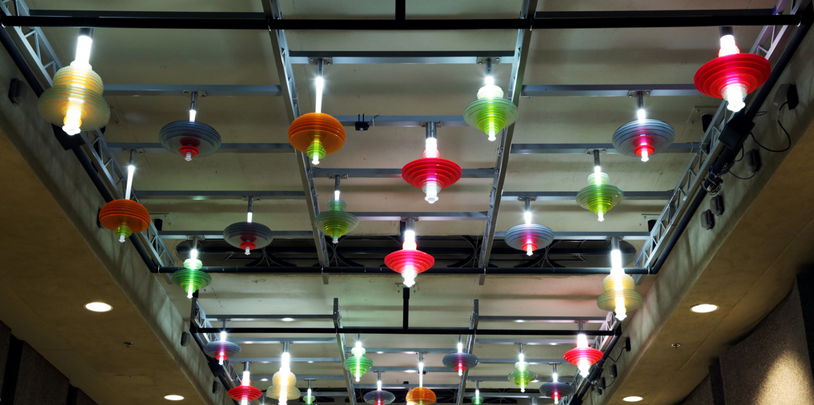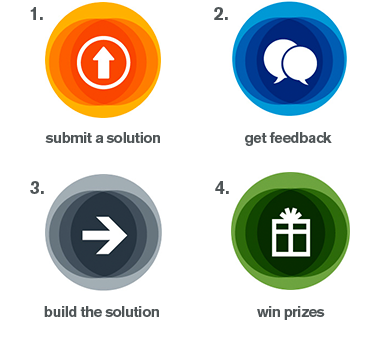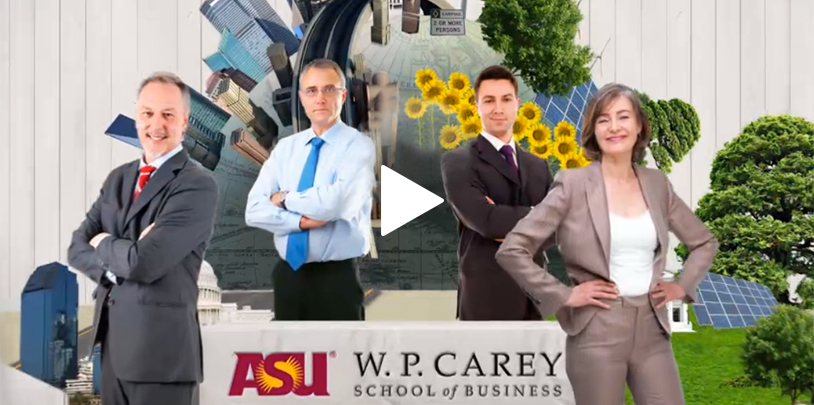Innovation

“We have built an exemplar knowledge enterprise that is focused on addressing global challenges through innovative transdisciplinary approaches,” said Sethuraman Panchanathan, senior vice president for knowledge enterprise development. “Our outstanding faculty, researchers and students are engaging in use-inspired research, advancing entrepreneurship and transforming society.”
Decision Theater
ASU’s Decision Theater offers innovative decision-making support to organizations and policymakers. With multiple screens and advanced support tools, communities can visualize complex issues and collaborate through the decision-making process, interacting with ASU research experts and scientists. The Decision Theater offers participants a unique way to make sense of issues ranging from urban growth and the environment to public health and education.

arts and sciences
ASU’s School of Earth and Space Exploration faculty members published an innovative textbook for introductory college geology courses. The book, “Exploring Geology,” was published by McGraw-Hill Higher Education and has already been widely adopted by universities and colleges across the country. This new style of textbook, designed from cognitive and educational research, recently received the McGraw-Hill Presidential Achievement Award for Innovation.
sustainability
ASU's School of Sustainability is the first school in the United States dedicated to exploring the principles of sustainability. Established in spring 2007, the school takes a transdisciplinary approach in its curriculum, addressing a broad spectrum of global challenges that bring together the university’s disciplines. Some highlights include:
• The W. P. Carey School of Business offers students the opportunity to study sustainability in the business sector with a focus on planning and profitability.
• The Herberger Institute for Design and the Arts partners with the School of Sustainability to address sustainable design challenges and interdisciplinary research through a doctorate of design, environment and the arts.
• ASU’s Lincoln Center for Applied Ethics offers a Master of Arts in Applied Ethics and the Professions with a sustainability-related concentration in Science, Technology and Ethics. This program allows students to look at ethics in relation to the economy, environment and prevalent social and cultural issues affected by the scientific and technological advances of today’s complex world.

community
In fall 2011, ASU invited the community to work on the world’s greatest challenges by launching the 10,000 Solutions project. Since then, there have been more than 2,100 solutions submitted to the 10,000 Solutions website.
10,000solutions.org is a problem-solving website that ignites the power of collaborative imagination. The project offers a place where students, faculty, staff, alumni and community members can share ideas to impact local and global communities as well as build on others' ideas. Users can comment on posts and “like” another user’s solution. In the first phase of 10,000 Solutions, which ended in May 2012, those who submitted solutions also could win a $10,000 prize.
technology and innovation
ASU’s College of Technology and Innovation houses the world’s largest algae testbed facility at any university or national lab. The Arizona Center for Algae Technology and Innovation (AzCATI) serves as a hub for research, testing and commercialization of algae-based products, which include biofuels, pharmaceuticals, nutraceuticals, and other algae biomass co-products that propel Arizona into the forefront of innovation in biofuels and bio-product research and development. The center also serves as a learning environment for the next generation of scientists and engineers. AzCATI provides open test and evaluation facilities for the algae industry and research community.


journalism
The Walter Cronkite School of Journalism and Mass Communication’s undergraduate and graduate curricula were completely overhauled in the last 10 years to focus on traditional journalism values and skills combined with deep immersions into digital media and intensive professional programs. This change positions Cronkite graduates to be leaders in innovative media technologies.
Directed by new media innovator, educator and journalist Dan Gillmor, the Cronkite School’s Knight Center for Digital Media Entrepreneurship offers students an environment that facilitates advancements in digital and new media. Addressing today’s rapidly changing media landscape, the center offers students the opportunity to develop the entrepreneurial skills needed to be leaders in creating new media and digital media products. In 2008, CJ Cornell was named the first Entrepreneur in Residence. He works with students to explore the business side of launching new media products and services and also teaches courses as professor of digital media entrepreneurship.
ASU recognizes the rapidly changing environment of media and journalism and is committed to delivering high-quality, forward-thinking education to its students. One such example is ASU’s New Media Innovation Lab in the Cronkite School. Here, students from various disciplines come together to research and develop unique multimedia products for media companies. Projects range from Facebook and iPhone applications to the award-winning AZ Political Directory for the Arizona Guardian (no longer in publication). The lab opened in 2006 and is directed by Retha Hill, an innovator and new media entrepreneur.
knowledge enterprise development
ASU is leveraging its place by harnessing the power of the sun for various research projects. In addition to having the largest solar installation of any university in the United States, ASU researchers and graduate students are converting sunlight into electricity to reduce the nation’s dependence on fossil fuels. By creating organic solar cells, researchers are developing affordable electricity solutions using the sun, one of the world’s largest sources of renewable energies.
Researchers at ASU’s Flexible Display Center (FDC) are working to advance full-color, video-rate, flexible electronic displays. Their efforts involve integrating sustainable microelectronics processing into all of the center’s activities. Research at center was cited as one of the top technological breakthroughs of 2008 by Wired magazine. In 2012, the FDC announced that it had successfully manufactured the world’s largest flexible color organic light-emitting display (OLED) prototype using advanced mixed oxide thin-film transistors (TFTs). The device was developed in conjunction with Army Research Laboratory scientists. It meets a critical target set by the U.S. Department of Defense to advance the development of full-color, full-motion video flexible OLED displays for use in thin, lightweight, bendable and highly rugged devices.
design and the arts
ASU’s Herberger Institute for Design and the Arts created the nation’s first proficiency-based digital media degree. “The Digital Culture Initiative positions students and faculty to imagine and invent solutions to the new challenges created by the new hybrid reality we face today,” says Kwang-Wu Kim, dean and director.
In the Arts, Media + Engineering labs at ASU’s Herberger Institute, engineers and artists pushed the frontiers of the technology in the medical field when digital media was used to train stroke patients how to more quickly regain mobility. The labs installed a scaled version of the Mixed Reality Rehabilitation system at the Rhodes Rehabilitation Institute at Banner Baywood Medical Center’s Mesa facility to enable patients to engage with audiovisual scenes, which allows them to practice physical movements that expedite recovery.
education
Through a $43.4 million initiative, ASU’s Mary Lou Fulton Teachers College Arizona Ready-for-Rigor Project implements and assesses performance-based incentive pay for teachers to increase student achievement, retain educators and foster exemplary school culture.
Teachers College unveiled Arizona’s first undergraduate degree offering dual certification in early childhood and special education. Children who have special needs can be identified early, receive intervention sooner and be part of inclusive classrooms with teachers who are trained to meet the needs of all children.
Teachers College established the Gary K. Herberger Young Scholars Academy, Arizona’s first university-based school specifically designed to meet the unique educational, social and emotional needs of gifted young adolescents. Educational programming moves at a rapid pace; students cover the traditional grade 7-12 curriculum during their first three years. Over the next two years, students engage in university work, and at the conclusion of what would otherwise be their junior year of high school, academy students will have earned as many as 45 ASU credits and be prepared to apply to continue their studies in any degree program on any ASU campus.
